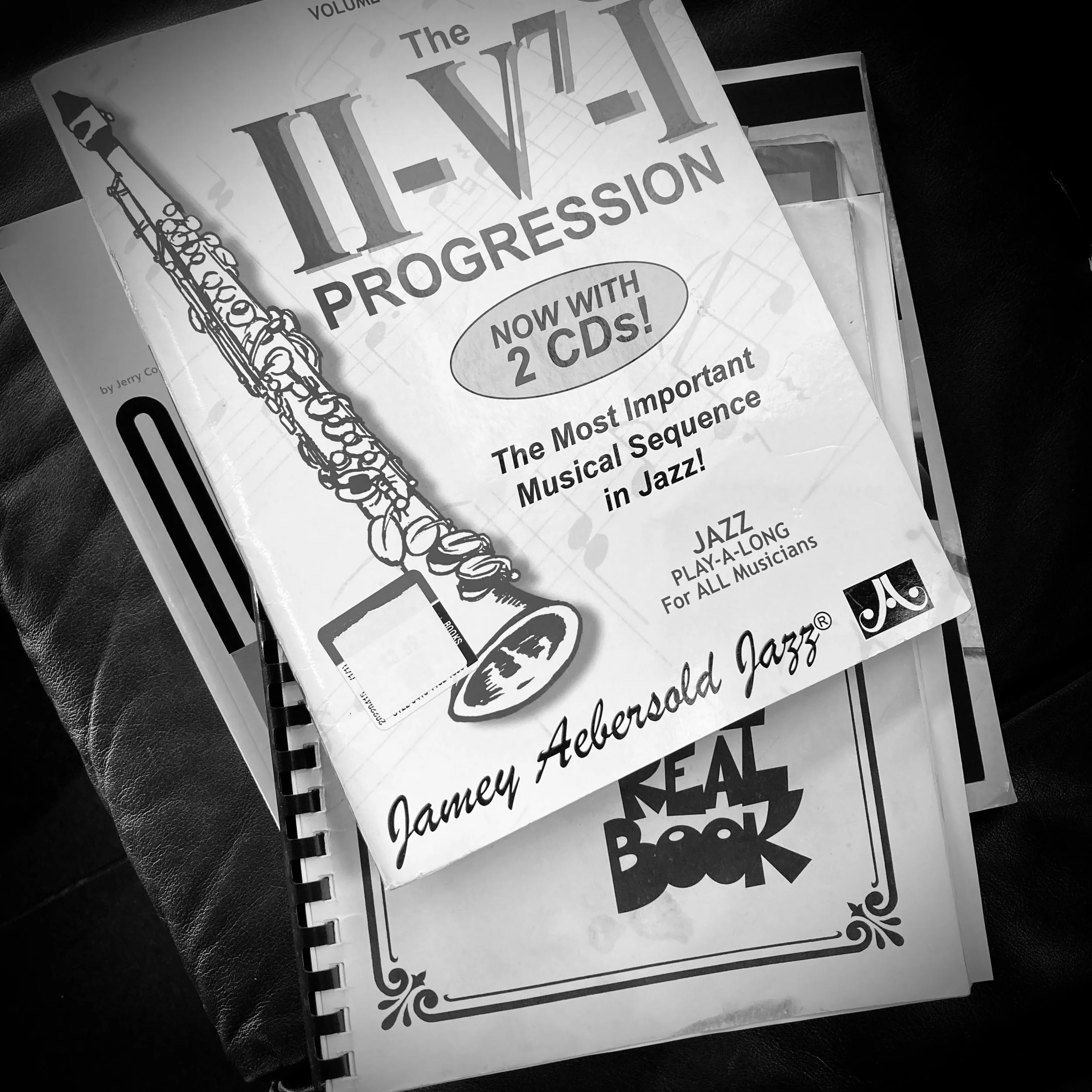So You've Got a Jazz Musician?
This post is still being edited. It is part of a presentation to the Fairfax-Loudoun Music Fellowship.
So you’ve got a student who wants to play jazz? Here are my top resources for getting your jazz journey started.
The Real Book
The Real Book is the most widely used fakebook—a kind of jazz bible that can get you through hundreds of gigs as you’re getting started. My original is pretty dog-eared. It contains lead sheets for many jazz tunes, both standards and obscure ones.
Tune List
Here’s a list of tunes from The Real Book a jazz beginning might like to tackle. These are chosen for two reasons. First, they’re fairly easy standards that one should know. Second, their chords work nicely with the voicings laid out in the Aebersold ii-V-I book without a lot of exceptions to the rules.
All of Me
Autumn Leaves
Beautiful Love
Blue Bossa
Don’t Get Around Much
The Girl From Ipamena
Have You Met Miss Jones
Here’s That Rainy Day
In a Mellow Tone
In a Sentimental Mood
Out of Nowhere
Recordame
Satin Doll
Solar
Take the “A” Train
There Will Never Be Another You
The Aebersold II-V7-I Book
This book was the place to start for me to get an introduction to jazz piano stylings. Jazz players think about chords in a slightly more complicated manner than I had learned in music theory class. The last four pages are an indispensable introduction to jazz piano voicing.
The jazz language. Jazz is a language—not that it can’t be expanded, but what has gone before is the starting place. Aebersold p. 44 #31 as an example. Sing with solfège.
Select Aebersold voicing and pattern samples.
Satin Doll
Today we’ll be looking at a couple of tunes. One is Satin Doll. We’re going to take the chord voicing from our Aebersold book and apply them to this tune.
iReal Pro
How does this fit into Aebersold? Practice? Learning tunes? Patterns?
Get 1400 jazz standards for iReal Pro.
Autumn Leaves
The version we’ll be using in Bb.
How to Actually Learn a Jazz Tune
—Listen
—Transcribe the melody
—Figure out the chords
—Transcribe part of a solo you like
—Memorize it
—Somewhere in here you can consult a chart from your RealBook
—Use your transcription to get ideas that you being to apply to other tunes.
—Repeat
Jim Snidero Play-Along
Jim Snidero has a series of books called Jazz Conceptions. Jim has spent years going through the process above and has made “improvisational style” solos to help students begin to speak the language of jazz.
Here’s his tune Autumn, based, of course, on Autumn Leaves.
I like to use the flute book to focus on melodies—and it’s in C like the piano, unlike most of the other books.
YouTube
All the resources you could need to learn jazz are here. This history of jazz, the players, tunes. Everything. If you had nothing buy YouTube, you could be amazing.
Transcribe
Here’s a great Miles Davis video that I’ve spend hours with.
So What
https://www.youtube.com/watch?v=zqNTltOGh5c
Slow it Down
There’s a setting on YouTube that lets you choose the tempo. Trying to figure out a line that’s tricky? Slow it down to 50% or 25%.
Pick a lick: https://youtu.be/zqNTltOGh5c?t=98
Now take that back to iReal. Try to play that idea in all 12 keys.
Put It Together
These resources work together.
So you want to learn Forest Flower.
1. Listen to the video:
https://www.youtube.com/watch?v=OtB8dEuEmNM
2. Check your work in the Real Book. Do the chords your were hearing match? Discuss. (The Real Books is often wrong, or may be a chart from a different version.)
3. What about that line at the 4:02 mark. Do you like that? Then transcribe it. Play the lick in all keys using iReal Pro.
4. Once you’ve learned the tune from the recording, go play along with iReal Pro to practice your own improvisations.
The reality is that learning jazz is, in a way, simple. Develop your ear by transcribing, Learning both tunes and solos. When you hear something you like, figure out the context, then become fluent with that idea—often taking it around the circle of fifths in a program like iReal Pro. Meanwhile, learn from other players, attend jam sessions, play whenever you can. Books of transcriptions, patterns, and theory are only helpful in the above context. Without the real listening, they’ll become a crutch to a kind of pseudo-jazz. (I know from experience.)
Additional Resources
While we get the most use out of doing our own transcriptions, it can still be useful to read through someone else’s.
Essential Ear Training for Today's Musician
A foundational skill and a life-long pursuit. Better ears.
Practical Jazz Piano: A Comprehensive Method
Dr. Larson was a professor at Shenandoah University and one of my most influential teachers, so of course I recommend his book.
